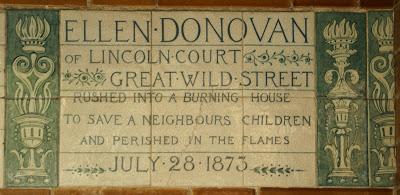
Like drownings, fires were a frequent cause of death in Victorian London. There was even a specialist charity dedicated to addressing the problem, the Society for the Protection of Life from Fire (founded in 1836, it still exists today - find its website here). Insurance companies had fire brigades fight the flames, but it was the Society which supplied ladders to help people escape. Although that role ended with the founding of the Metropolitan Fire Brigade, the Society continued to honor those who carried out brave rescues. Indeed, this was the organisation which commended Alice Ayres and sent her father a financial award.
Although such organisations sought to encourage others' efforts to rescue victims from fires, the rescues themselves could be dangerous or fatal. We have already seen several such deaths commemorated on the Watts Memorial: not only that of Alice Ayres but also George Stephen Funnell. However, there is something especially tragic about the death of Ellen Donovan since the children she went to rescue had in fact already escaped.
The fire broke out in Lincoln Court, Drury Lane in July 1873. It had begun in the room of a Ms Cowan, who had locked it and gone out. A Mrs Hussey from the floor above discovered it, and rescued several children with her husband. However, when Donovan came along later and asked "if the poor brats were out" she was wrongly told that they were still inside. She rushed to the top floor and found it empty, but as she tried to leave the staircase was on fire; the roof collapsed; and Donovan died before she could be rescued.
ELLEN DONOVAN OF LINCOLN COURT, GREAT WILD STREET RUSHED INTO A BURNING HOUSE TO SAVE A NEIGHBOUR'S CHILDREN AND PERISHED IN THE FLAMES, JULY 28 1873.
The newspaper report of the inquest ends with further details indicating the relative poverty of the area. The houses of Lincoln Court were built of wood; there were 21, each with 8 rooms, and 366 inhabitants. That meant an average of 17 or 18 people to each house. Nonetheless, the district sanitary inspector described them as 'perfectly habitable'.

